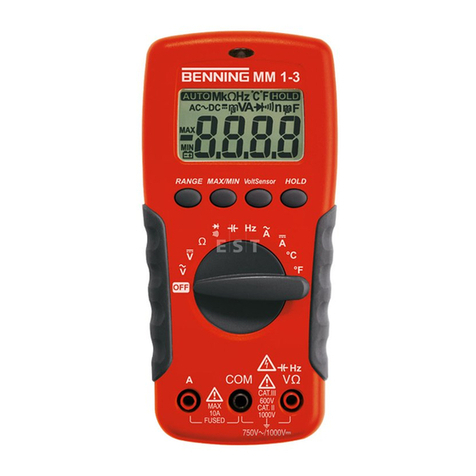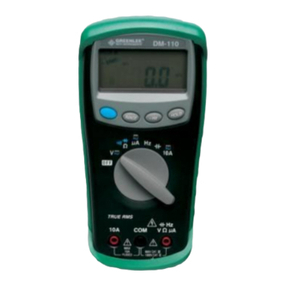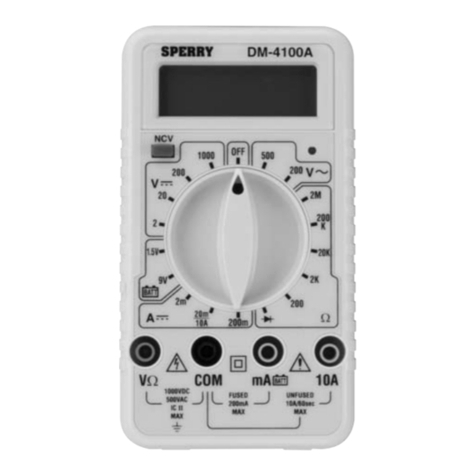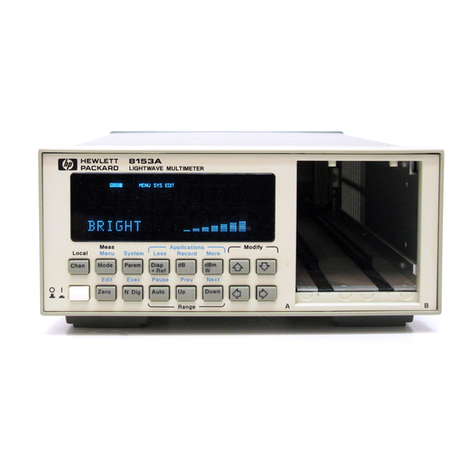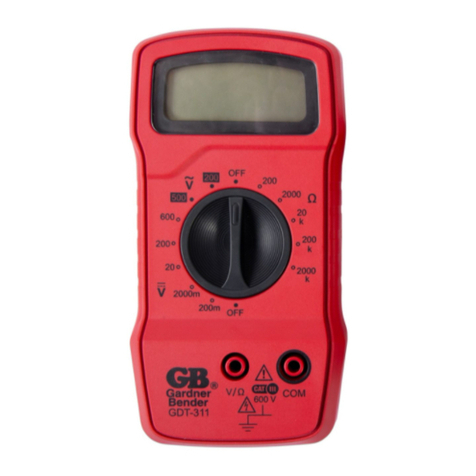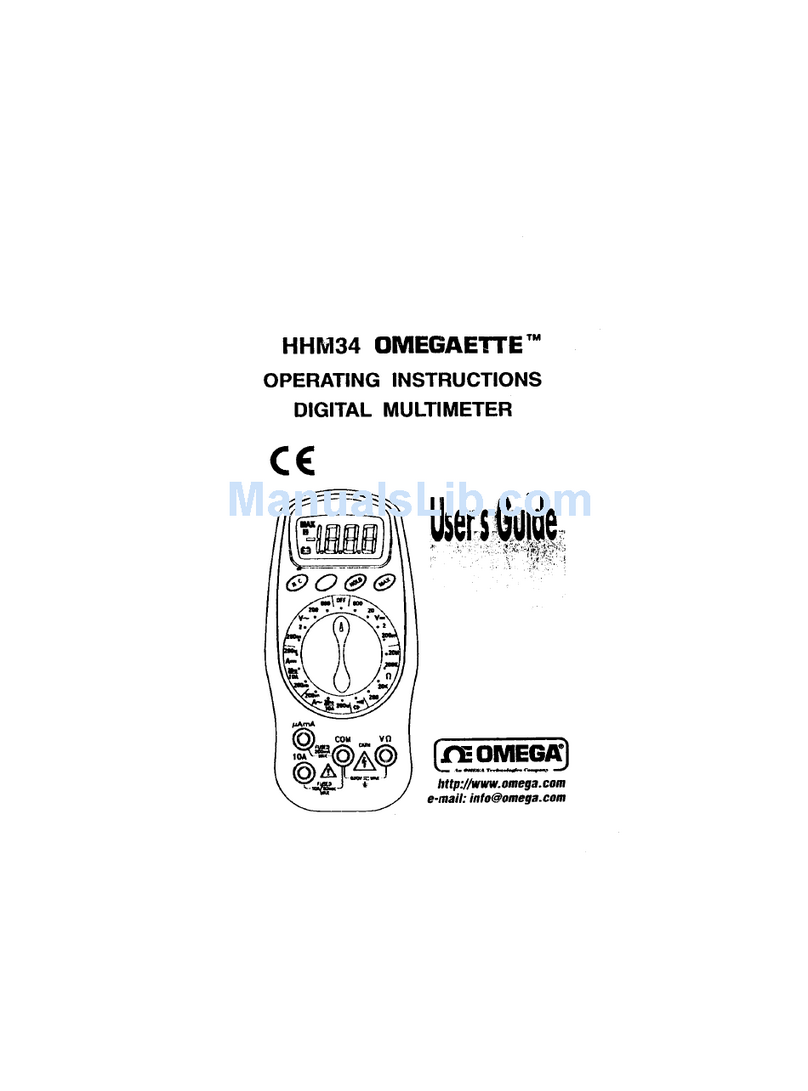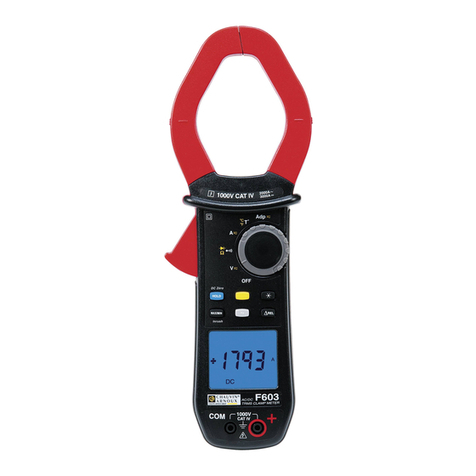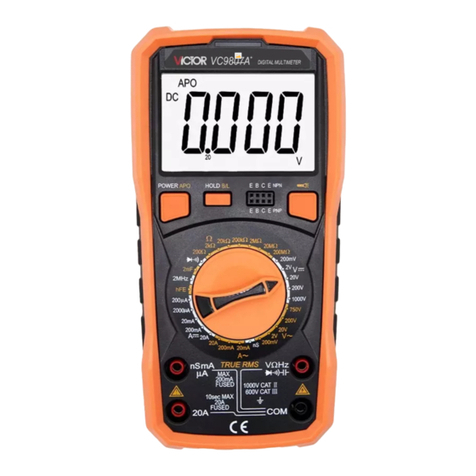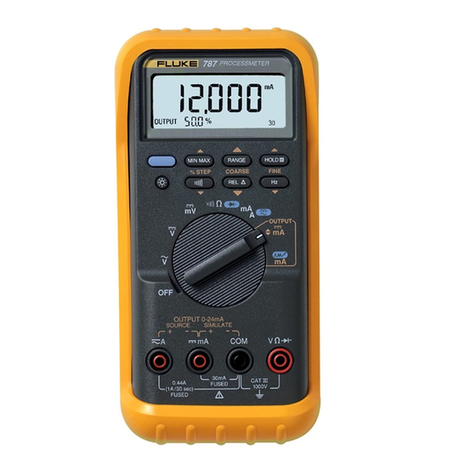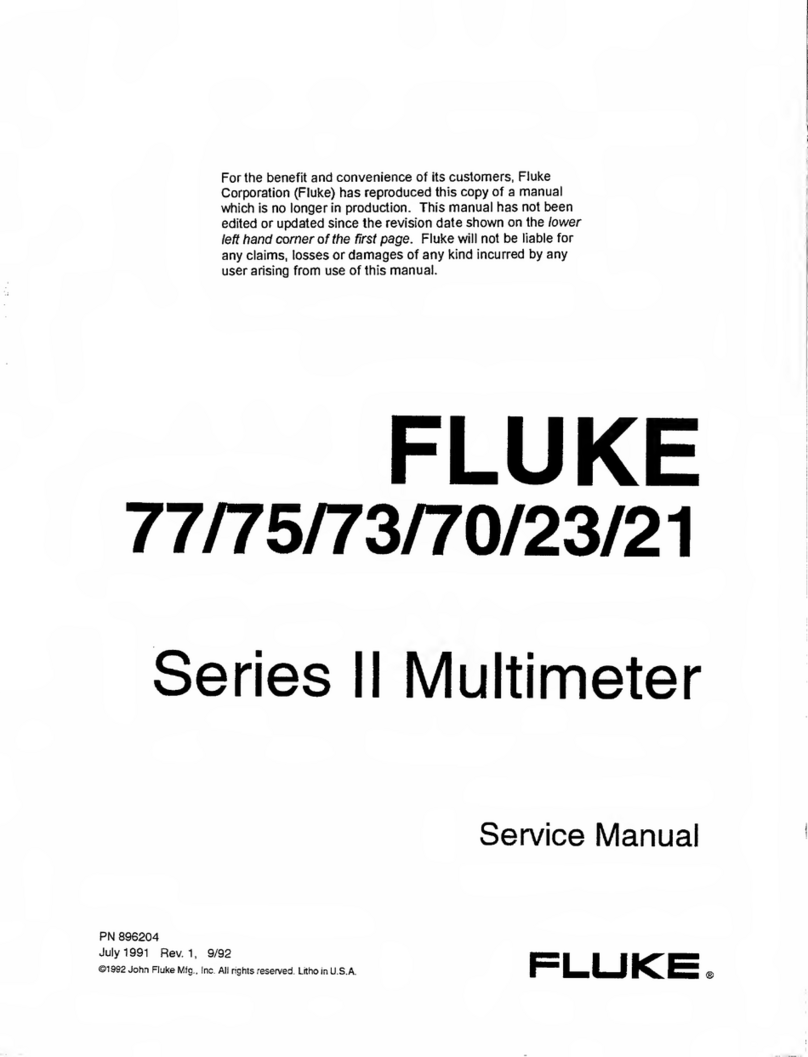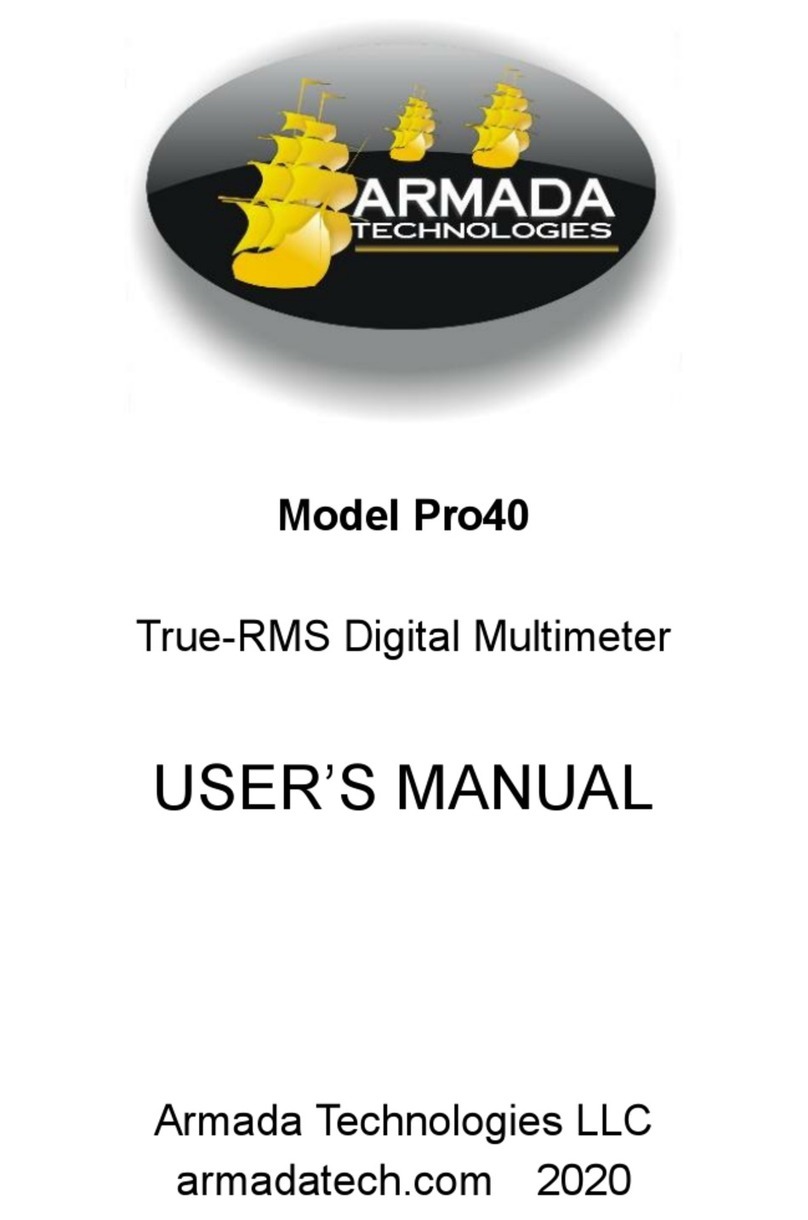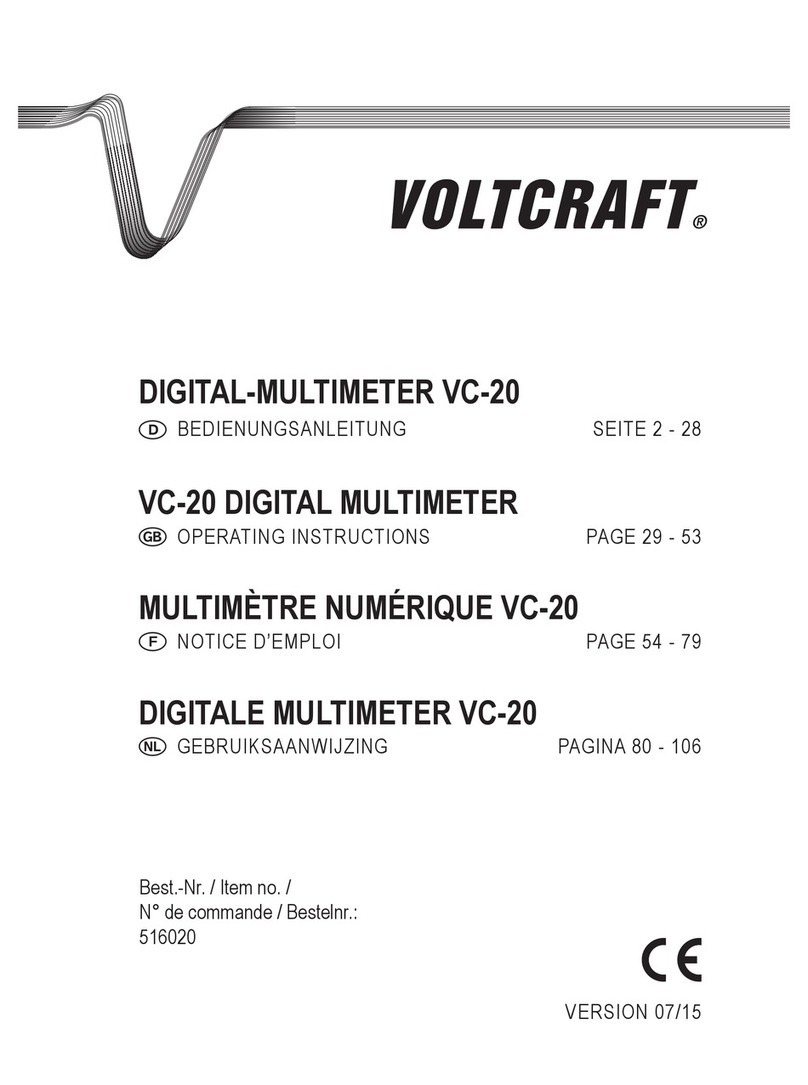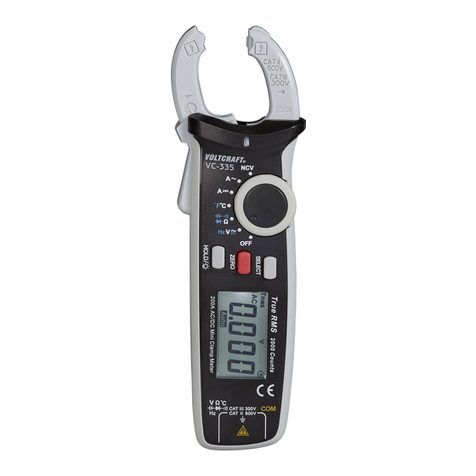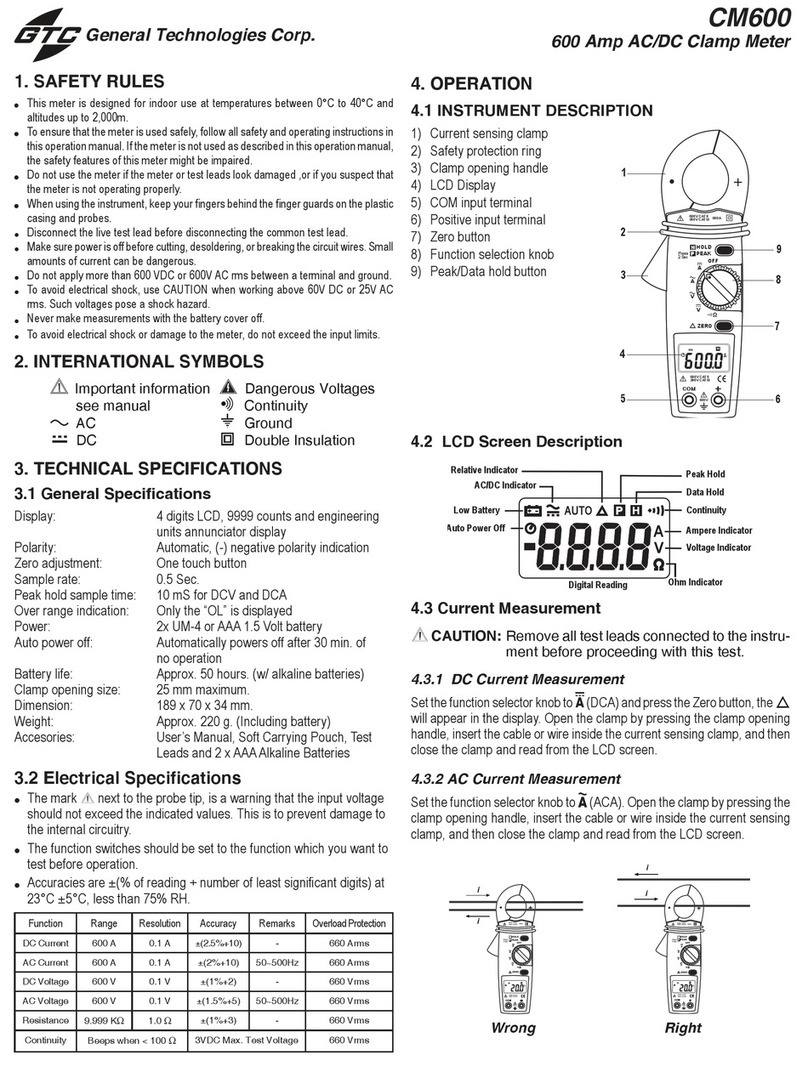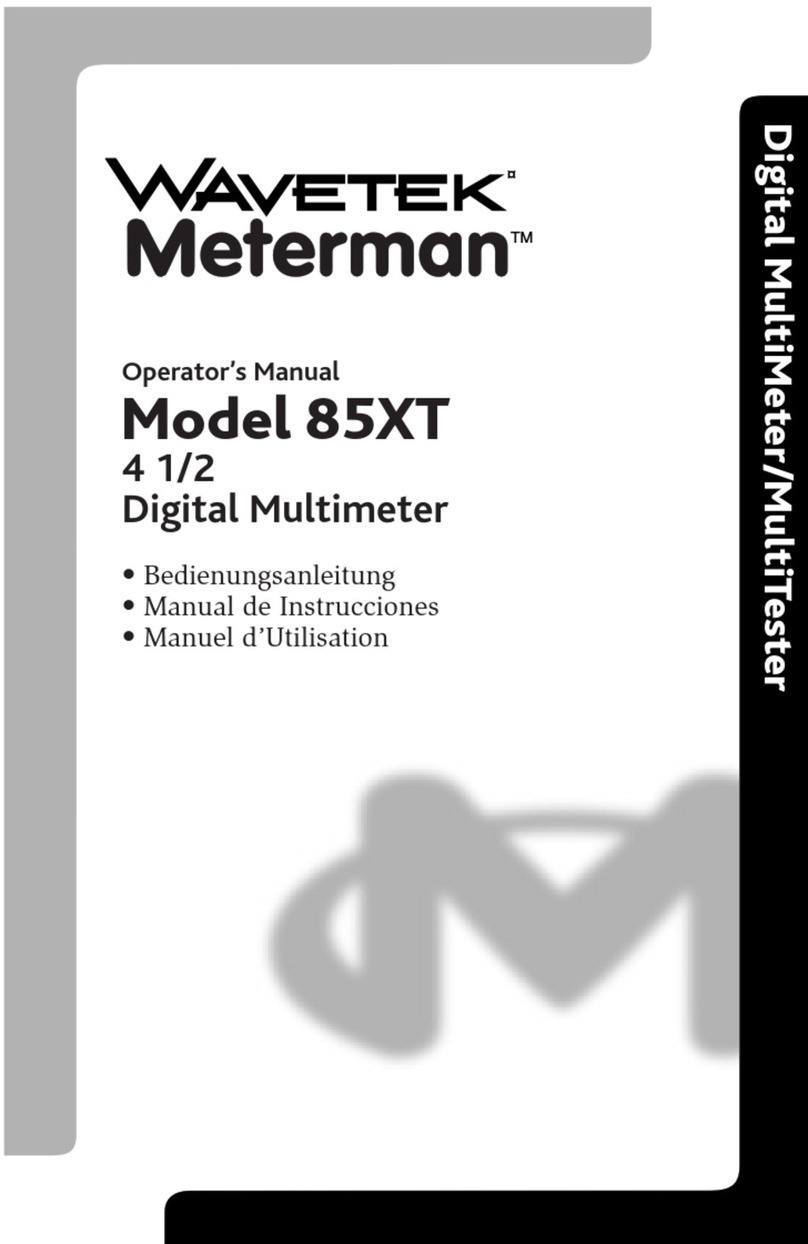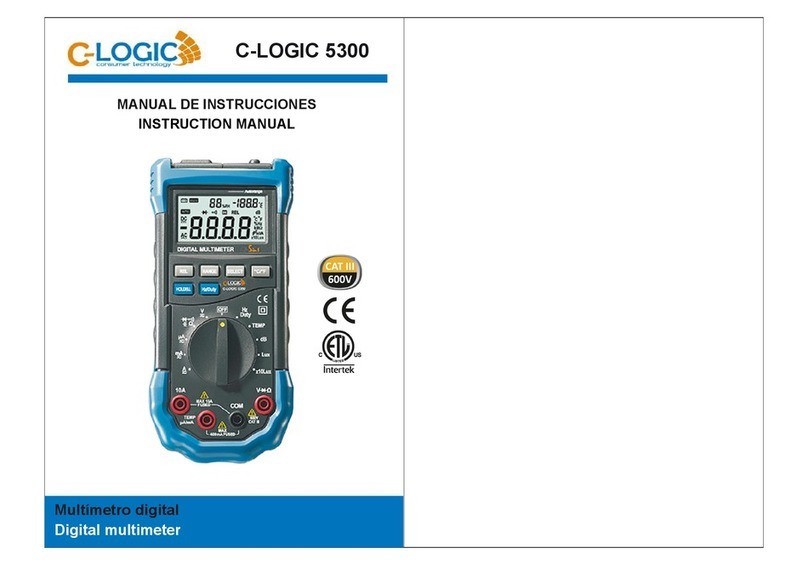Benning MM 3 User manual

Bedienungsanleitung
Operating manual
Notice d‘emploi
Gebruiksaanwijzing
Instrucciones de servicio
Bruksanvisning
Istruzioni d’uso
BENNING MM 3
Benning Elektrotechnik & Elektronik GmbH & Co. KG
Münsterstraße 135 - 137
D - 46397 Bocholt
++49 (0) 2871 - 93 - 0 • Fax ++49 (0) 2871 - 93 - 429
Bild 1: Gerätefrontseite
Fig. 1: Front tester panel
Fig. 1: Panneau avant de l‘appareil
Fig. 1: Voorzijde van het apparaat
Fig. 1: Parte frontal del equipo
Fig. 1: Framsida
ill. 1: Lato anteriore apparecchio
08/ 2004
BENNING MM 3
08/ 2004
BENNING MM 3
Bild 2: Gleichspannungsmessung
Fig. 2: Direct voltage measurement
Fig. 2: Mesure de tension continue
Fig. 2: Meten van gelijkspanning
Fig. 2: Medición de tension contínua
Fig. 2: Likspänningsmätning
ill. 2: Misura tensione continua
Bild 3: Wechselspannungsmessung
Fig. 3: Alternating voltage measurement
Fig. 3: Mesure de tension alternative
Fig. 3: Meten van wisselspanning
Fig. 3: Medición de tensión alterna
Fig. 3: Växelspänningsmätning
ill. 3: Misura tensione alternata
Bild 4: Gleichstrommessung
Fig. 4: DC current measurement
Fig. 4: Mesure de courant continu
Fig. 4: Meten van gelijkstroom
Fig. 4: Medición de corriente contínua
Fig. 4: Likströmsmätning
ill. 4: Misura corrente continua

08/ 2004
BENNING MM 3
08/ 2004
BENNING MM 3
08/ 2004
BENNING MM 3
08/ 2004
BENNING MM 3
Bild 12: Sicherungswechsel
Fig. 12: Fuse replacement
Fig. 12: Remplacement des fusibles
Fig. 12: Vervanging van de smeltzekeringen
Fig. 12: Cambio de fusible
Fig. 12: Säkringsbyte
ill. 12: Sostituzione fusibile Bild 14: Aufstellung des BENNING MM 3
Fig. 14: Standing up the BENNING MM 3
Fig. 14: Installation du BENNING MM 3
Fig. 14: Opstelling van de multimeter BENNING MM 3
Fig. 14: Colocación del BENNING MM 3
Fig. 14: Instrumentstöd BENNING MM 3
ill. 14: Posizionamento del BENNING MM 3
Bild 13: Aufwicklung der Sicherheitsmessleitung
Fig. 13: Wrapping up the safety test leads
Fig. 13: Enroulement du câble de mesure de sécurité
Fig. 13: Wikkeling van veiligheidsmeetsnoeren
Fig. 13: Arrollamiento de la conducción protegida de medición
Fig. 13: Placering av säkerhetsmätsladdar
ill. 13: Avvolgimento dei cavetti di sicurezza
Bild 9: Kapazitätsmessung
Fig. 9: Capacity Testing
Fig. 9: Mesure de capacité
Fig. 9: Capaciteitsmeting
Fig. 9: Medición de capacidad
Fig. 9: Kapacitansmätning
ill. 9: Misura di capacità
Bild 8: Durchgangsprüfung mit Summer
Fig. 8: Continuity Testing with buzzer
Fig. 8: Contrôle de continuité avec ronfleur
Fig. 8: Doorgangstest met akoestisch signaal
Fig. 8: Control de continuidad con vibrador
Fig. 8: Genomgångstest med summer
ill. 8: Prova di continuità con cicalino
Bild 10: Frequenzmessung
Fig. 10: Frequency measurement
Fig. 10: Mesure de fréquence
Fig. 10: Frequentiemeting
Fig. 10: Medición de frecuencia
Fig. 10: Frekvensmätning
ill. 10: Misura di capacità
Bild 11: Batteriewechsel
Fig. 11: Battery replacement
Fig. 11: Remplacement de la pile
Fig. 11: Vervanging van de batterijen
Fig. 11: Cambio de pila
Fig. 11: Batteribyte
ill. 11: Sostituzione batterie
Bild 6: Widerstandsmessung
Fig. 6: Resistance measurement
Fig. 6: Mesure de résistance
Fig. 6: Weerstandsmeting
Fig. 6: Medición de resistencia
Fig. 6: Resistansmätning
ill. 6: Misura di resistenza
Bild 7: Diodenprüfung
Fig. 7: Diode Testing
Fig. 7: Contrôle de diodes
Fig. 7: Diodecontrole
Fig. 7: Verificación de diodos
Fig. 7: Diod-test
ill. 7: Prova diodi
Bild 5: Wechselstrommessung
Fig. 5: AC current measurement
Fig. 5: Mesure de courant alternatif
Fig. 5: Meten van wisselstroom
Fig. 5: Medición de corriente alterna
Fig. 5: Växelströmsmätning
ill. 5:
Misura corrente alternata

10/ 2004
BENNING MM 3
1
Bedienungsanleitung
BENNING MM 3
Digital-Multimeter zur
- Gleichspannungsmessung
- Wechselspannungsmessung
- Gleichstrommessung
- Wechselstrommessung
- Widerstandsmessung
- Diodenprüfung
- Durchgangsprüfung
- Kapazitätsmessung
- Frequenzmessung
Inhaltsverzeichnis
1. Benutzerhinweise
2. Sicherheitshinweise
3. Lieferumfang
4. Gerätebeschreibung
5. Allgemeine Angaben
6. Umgebungsbedingungen
7. Elektrische Angaben
8. Messen mit dem BENNING MM 3
9. Instandhaltung
10. Anwendung des Gummi-Schutzrahmens
1. Benutzerhinweise
Diese Bedienungsanleitung richtet sich an
- Elektrofachkräfte und
- elektrotechnisch unterwiesene Personen
Das BENNING MM 3 ist zur Messung in trockener Umgebung vorgesehen. Er
darf nicht in Stromkreisen mit einer höheren Nennspannung als 600 V DC/AC ein-
gesetzt werden (Näheres hierzu im Abschnitt 6. "Umgebungsbedingungen").
In der Bedienungsanleitung und auf dem BENNING MM 3 werden folgende
Symbole verwendet:
Dieses Symbol weist auf elektrische Gefahr hin.
Dieses Symbol weist auf Gefährdungen beim Gebrauch des
BENNING MM 3 hin. (Dokumentation beachten!)
Dieses Symbol auf dem BENNING MM 3 bedeutet, dass das Gerät
schutzisoliert (Schutzklasse II) ausgeführt ist.
Dieses Symbol auf dem BENNING MM 3 weist auf die eingebauten
Sicherungen hin.
Dieses Symbol erscheint in der Anzeige für eine entladene
Batterie.
Dieses Symbol kennzeichnet den Bereich “Durchgangsprüfung”.Der
Summer dient der akustischen Ergebnisausgabe.
Dieses Symbol kennzeichnet den Bereich „Diodenprüfung“.
(DC) Gleichspannung.
(AC) Wechsel- Spannung oder Strom.
Masse (Spannung gegen Erde).
Kondensator (Buchsen)

10/ 2004
BENNING MM 3
2
2. Sicherheitshinweise
Beispiel für einen Sicherheitshinweis:
Elektrische Gefahr!
Beachten Sie die Sicherheitshinweise!
Bevor Sie den BENNING MM 3 benutzen, lesen Sie bitte die Bedienungsanlei-
tung sorgfältig. Beachten Sie die Sicherheitshinweise in der Bedienungsanleitung.
Damit schützen Sie sich vor Unfällen und den BENNING MM 3 vor Schaden.
3. Lieferumfang
Zum Lieferumfang des BENNING MM 3 gehören:
3.1 ein Stück BENNING MM 3,
3.2 ein Stück Sicherheitsmessleitung, rot (L = 1,4 m; Spitze Ø = 4 mm) mit
Schutzkappen,
3.3 ein Stück Sicherheitsmessleitung, schwarz (L = 1,4 m; Spitze Ø = 4 mm)
mit Schutzkappen,
3.4 ein Stück Gummi-Schutzrahmen,
3.5 ein Stück Kompakt-Schutztasche,
3.6 eine 9-V-Blockbatterie und zwei unterschiedliche Sicherungen (zur Erst-
bestückung im Gerät eingebaut),
3.7 die Bedienungsanleitung.
Hinweis auf Verschleißteile:
- Das BENNING MM 3 enthält Sicherungen zum Überlastschutz:
Ein Stück Sicherung Nennstrom 16 A flink (500 V), D = 6,35 mm, L = 32
mm und ein Stück Sicherung Nennstrom 1 A flink (500 V), D = 6,35 mm, L =
32 mm.
- Das BENNING MM 3 wird durch eine eingebaute 9-V-Blockbatterie (IEC 6
LR 61) gespeist.
4. Gerätebeschreibung
siehe Bild 1: Gerätefrontseite
Die in Bild 1 angegebenen Anzeige- und Bedienelemente werden wie folgt
bezeichnet:
Digitalanzeige für den Messwert, Anzeige der Bereichsüberschreitung,
Polaritätsanzeige,
Batterieanzeige, erscheint bei entladener Batterie,
Wahlschalter für Gleichspannung (DC) bzw. Wechselspannung (AC),
Drehschalter, für Wahl der Funktion und des Bereichs,
Buchsen für Kapazitätsmessungen,
Buchse (positive1) für V, Ω und Hz,
COM-Buchse, gemeinsame Buchse für Strom-, Spannungs-, Widerstands-,
Frequenzmessungen, Durchgangs- und Diodenprüfung,
Buchse (positive) für µA/ mA-Bereich, für Ströme bis 200 mA,
Buchse (positive) für 20 A-Bereich, für Ströme bis 20 A,
Gummi-Schutzrahmen
1) Hierauf bezieht sich die automatische Polaritätsanzeige für Gleichstrom- und Spannung
5. Allgemeine Angaben
5.1 Allgemeine Angaben zum BENNING MM 3
5.1.1 Die Digitalanzeige ist als 3½-stellige Flüssigkristallanzeige mit 20 mm
Schrifthöhe mit Dezimalpunkt ausgeführt. Der größte Anzeigewert ist
1999.
5.1.2 Die Polaritätsanzeige wirkt automatisch. Es wird nur eine Polung
entgegen der Buchsendefinition mit "-" angezeigt.
5.1.3 Die Bereichsüberschreitung wird mit "1" oder "-1" angezeigt.
5.1.4 Die Messrate des BENNING MM 3 beträgt nominal 2,5 Messungen pro
Sekunde.
5.1.5 Das BENNING MM 3 wird durch den Drehschalter ein- oder ausge-
schaltet. Ausschaltstellung "OFF".
5.1.6 Das BENNING MM 3 schaltet nach ca. 30 min selbsttätig ab. Er schal-
tet wieder ein, wenn am Drehschalter ein anderer Bereich gewählt
wird.
5.1.7 Temperaturkoeffizient des Messwertes: 0,15 x (angegebene Messge-
nauigkeit)/ °C < 18 °C oder > 28 °C, bezogen auf den Wert bei der
Referenztemperatur 23 °C.
5.1.8 Das BENNING MM 3 wird durch eine 9-V-Blockbatterie gespeist
(IEC 6 LR 61).
5.1.9
Wenn die Batteriespannung unter die vorgesehene Arbeitsspannung des
BENNING MM 3 sinkt, dann erscheint in der Anzeige ein Batteriesymbol.

10/ 2004
BENNING MM 3
3
5.1.10 Die Lebensdauer einer Batterie beträgt etwa 150 Stunden (Alkali-
batterie).
5.1.11 Geräteabmessungen:
(L x B x H) = 175 x 84 x 31 mm ohne Gummi-Schutzrahmen
(L x B x H) = 192 x 95 x 50 mm mit Gummi-Schutzrahmen
Gerätegewicht:
340 g ohne Gummi-Schutzrahmen
550 g mit Gummi-Schutzrahmen
5.1.12 Die Sicherheitsmessleitungen sind in 4 mm-Stecktechnik ausgeführt.
Die mitgelieferten Sicherheitsmessleitungen sind ausdrücklich für die
Nennspannung und dem Nennstrom des BENNING MM 3 geeignet.
Die Messspitzen können durch Schutzkappen geschützt werden.
5.1.13 Das BENNING MM 3 wird durch einen Gummi-Schutzrahmen vor
mechanischer Beschädigung geschützt. Der Gummi-Schutzrahmen
ermöglicht es, den BENNING MM 3 während der Messungen aufzu-
stellen oder aufzuhängen.
6. Umgebungsbedingungen
- Das BENNING MM 3 ist für Messungen in trockener Umgebung vorge-
sehen,
- Barometrische Höhe bei Messungen: Maximal 2000 m,
- Überspannungskategorie/Aufstellungskategorie: IEC 664/ IEC 1010- 1:1990
→ 600 V Kategorie II; 300 V Kategorie III,
- Verschmutzungsgrad: II,
- Schutzart: IP 30 (DIN VDE 0470-1 IEC/ EN 60529)
3 - erste Kennziffer: Schutz gegen Zugang zu gefährlichen Teilen und
Schutz gegen feste Fremdkörper, > 2,5 mm Durchmesser
0 - zweite Kennziffer: Kein Wasserschutz,
- Arbeitstemperatur und relative Luftfeuchte:
Bei Arbeitstemperatur von 0 °C bis 30 °C: relative Luftfeuchte kleiner 80 %,
Bei Arbeitstemperatur von 30 °C bis 40 °C: relative Luftfeuchte kleiner 75 %,
Bei Arbeitstemperatur von 40 °C bis 50 °C: relative Luftfeuchte kleiner 45 %,
- Lagerungstemperatur: Der BENNING MM 3 kann bei Temperaturen von - 20 °C
bis + 60 °C gelagert werden. Dabei ist die Batterie aus dem Gerät heraus
zu nehmen.
7. Elektrische Angaben
Bemerkung: Die Messgenauigkeit wird angegeben als Summe aus
- einem relativen Anteil des Messwertes und
- einer Anzahl von Digit (d.h. Zahlenschritte der letzten Stelle).
Diese Messgenauigkeit gilt bei Temperaturen von 18 °C bis 28 °C und einer
relativen Luftfeuchtigkeit kleiner 75 %.
7.1 Gleichspannungsbereiche
Der Eingangswiderstand beträgt 10 MΩ.
Messbereich Auflösung Messgenauigkeit Überlastschutz
200 mV 100 µV ± (0,5 % des Messwertes + 2 Digit) 600 Veff
2 V 1 mV ± (0,5 % des Messwertes + 2 Digit) 600 Veff
20 V 10 mV ± (0,5 % des Messwertes + 2 Digit) 600 Veff
200 V 100 mV ± (0,5 % des Messwertes + 2 Digit) 600 Veff
600 V 1 V ± (0,5 % des Messwertes + 2 Digit) 600 Veff
7.2 Wechselspannungsbereiche
Der Eingangswiderstand beträgt 10 M parallel 100 pF. Der Messwert wird
durch Mittelwertgleichrichtung gewonnen und als Effektivwert angezeigt.
Mess-
bereich Auflösung Messgenauigkeit
im Frequenzbereich 40 Hz - 500 Hz Überlastschutz
200 mV 100 µV ± (1,3 % des Messwertes + 5 Digit) 600 Veff
2 V 1 mV ± (1,3 % des Messwertes + 5 Digit) 600 Veff
20 V 10 mV ± (1,3 % des Messwertes + 5 Digit) 600 Veff
200 V 100 mV ± (1,3 % des Messwertes + 5 Digit) 600 Veff
600 V 1 V ± (1,3 % des Messwertes + 5 Digit) 600 Veff
7.3 Gleichstrombereiche
Überlastungsschutz:
- 1 A (500 V)-Sicherung, flink am µA/ mA - Eingang,
- 16 A (500 V)-Sicherung, flink am 20 A - Eingang,

10/ 2004
BENNING MM 3
4
Strommessungen im 20 A-Bereich sollen kurzzeitig sein (Zeit < 30 Sekunden,
Pause 3 Minuten), 10 A dauernd.
Messbereich Auflösung Messgenauigkeit Spannungsabfall
200 µA 0,1 µA ± (1,0 % des Messwertes + 2 Digit) 600 mV max.
2 mA 1 µA ± (1,0 % des Messwertes + 2 Digit) 600 mV max.
20 mA 10 µA ± (1,0 % des Messwertes + 2 Digit) 600 mV max.
200 mA 100 µA ± (1,0 % des Messwertes + 2 Digit) 900 mV max.
20 A 10 mA ± (2,0 % des Messwertes + 3 Digit) 900 mV max.
7.4 Wechselstrombereiche
Der Messwert wird durch Mittelwertgleichrichtung gewonnen und als Effektivwert
angezeigt.
Überlastungsschutz:
- 1 A (500 V)-Sicherung, flink am µA/ mA - Eingang,
- 16 A (500 V)-Sicherung, flink am 20 A - Eingang,
Strommessungen im 20 A-Bereich sollen kurzzeitig sein (Zeit < 30 Sekunden,
Pause 3 Minuten), 10 A dauernd.
Messbereich Auflösung Messgenauigkeit
im Frequenzbereich 40 Hz - 500 Hz Spannungsabfall
200 µA 0,1 µA ± (1,5 % des Messwertes + 3 Digit) 600 mVeff max.
2 mA 1 µA ± (1,5 % des Messwertes + 3 Digit) 600 mVeff max.
20 mA 10 µA ± (1,5 % des Messwertes + 3 Digit) 600 mVeff max.
200 mA 100 µA ± (1,5 % des Messwertes + 3 Digit) 900 mVeff max.
20 A 10 mA ± (2,5 % des Messwertes + 5 Digit) 900 mVeff max.
7.5 Widerstandsbereiche
Überlastschutz bei Widerstandsmessungen: 600 Veff.
Mess-
bereich
Auf-
lösung
Messgenauigkeit
Max.
Messstrom
Max. Leerlauf-
spannung
200 Ω 0,1 Ω ± (0,8 % des Messwertes + 4 Digit) 2,5 mA 3,2 V
2 kΩ 1 Ω ± (0,8 % des Messwertes + 2 Digit) 200 µA 0,5 V
20 kΩ 10 Ω ± (0,8 % des Messwertes + 2 Digit) 40 µA 0,5 V
200 kΩ 100 Ω ± (0,8 % des Messwertes + 2 Digit 4 µA 0,5 V
2 MΩ 1 kΩ ± (0,8 % des Messwertes + 2 Digit 400 nA 0,5 V
20 MΩ 10 kΩ ± (2 % des Messwertes + 5 Digit) 40 nA 0,5 V
7.6 Dioden- und Durchgangsprüfung
Die angegebene Messgenauigkeit gilt im Bereich zwischen 0,4 V und 0,9 V.
Überlastschutz bei Diodenprüfungen: 600 Veff
Der eingebaute Summer ertönt bei einem Widerstand R kleiner 50 Ω.
Messbereich Auflösung Messgenauigkeit Maximaler
Messstrom
Max. Leer-
laufspannung
1 mV
± (1,5 % des Messwertes + 5 Digit)
1,5 mA 3,2 V
7.7 Kapazitätsbereiche
Bedingungen: Kondensatoren entladen und entsprechend der angegebenen
Polarität angelegt.
Messbereich Auflösung Messgenauigkeit Messfrequenz
2 nF 1 pF ± (2,0 % des Messwertes + 4 Digit) 40 Hz
20 nF 10 pF ± (2,0 % des Messwertes + 4 Digit) 40 Hz
200 nF 100 pF ± (2,0 % des Messwertes + 4 Digit) 40 Hz

10/ 2004
BENNING MM 3
5
2 µF 1 nF ± (2,0 % des Messwertes + 4 Digit) 40 Hz
20 µF 10 nF ± (2,0 % des Messwertes + 4 Digit) 40 Hz
200 µF 100 nF ± (2,0 % des Messwertes + 4 Digit) 40 Hz
7.8 Frequenzbereiche
Die zu messende Frequenz muss mit einer Spannung größer 200 mVeff an den
Buchsen anliegen.
Mess-
bereich
Auf-
lösung
Messgenauigkeit
für 5 Veff max.
Min. Eingangs-
frequenz
Überlast-
schutz
2 kHz 1 Hz ± (1,0 % des Messwertes + 3 Digit) 20 Hz 600 Veff
20 kHz 10 Hz ± (1,0 % des Messwertes + 3 Digit) 200 Hz 600 Veff
200 kHz 100 Hz ± (1,0 % des Messwertes + 3 Digit) 2 kHz 600 Veff
8. Messen mit dem BENNING MM 3
8.1 Vorbereiten der Messung
Benutzen und lagern Sie den BENNING MM 3 nur bei den angegebenen
Lager- und Arbeitstemperaturbedingungen, vermeiden Sie dauernde Sonnen-
einstrahlung.
- Angaben von Nennspannung und Nennstrom auf den Sicherheitsmessleitun-
gen überprüfen. Die zum Lieferumfang gehörenden Sicherheitsmessleitungen
entsprechen in Nennspannung und Nennstrom dem BENNING MM 3.
- Isolation der Sicherheitsmessleitungen überprüfen. Wenn die Isolation
beschädigt ist, dann sind die Sicherheitsmessleitungen sofort auszuson-
dern.
- Sicherheitsmessleitungen auf Durchgang prüfen. Wenn der Leiter in der
Sicherheitsmessleitung unterbrochen ist, dann sind die Sicherheitsmess-
leitungen sofort auszusondern.
- Bevor am Drehschalter eine andere Funktion gewählt wird, müssen die
Sicherheitsmessleitungen von der Messstelle getrennt werden.
- Starke Störquellen in der Nähe des BENNING MM 3 können zu instabiler
Anzeige und zu Messfehlern führen.
8.2 Spannungs- und Strommessung
Maximale Spannung gegen Erdpotential beachten!
Elektrische Gefahr!
Die höchste Spannung, die an den Buchsen,
- COM-Buchse
- Buchse für V, Ω und Hz
- Buchse für µA/ mA-Bereich und der
- Buchse für 20 A-Bereich
des BENNING MM 3 gegenüber Erde liegen darf, beträgt 600 V.
Elektrische Gefahr!
Maximale Schaltkreisspannung bei Strommessung 500 V! Bei
Sicherungsauslösung über 500 V ist eine Beschädigung des
Gerätes möglich. Von einem beschädigten Gerät kann eine
elektrische Gefährdung ausgehen!
8.2.1 Spannungsmessung
- Mit dem Drehschalter den Bereich am BENNING MM 3 wählen.
- Mit dem Wahlschalter Gleichspannung (DC) /Wechselspannung (AC) am
BENNING MM 3 die zu messende Spannungsart wählen.
- Die schwarze Sicherheitsmessleitung mit der COM-Buchse am
BENNING MM 3 kontaktieren.
- Die rote Sicherheitsmessleitung mit der Buchse für V, Ω und Hz am
BENNING MM 3 kontaktieren.
- Die Sicherheitsmessleitungen mit den Messpunkten kontaktieren, Mess-
wert an der Digitalanzeige am BENNING MM 3 ablesen.
siehe Bild 2: Gleichspannungsmessung
siehe Bild 3: Wechselspannungsmessung

10/ 2004
BENNING MM 3
6
8.2.2 Strommessung
- Mit dem Drehschalter Bereich am BENNING MM 3 wählen.
- Mit dem Wahlschalter Gleichspannung (DC) /Wechselspannung (AC) am
BENNING MM 3 die zu messende Spannungsart bzw. Stromart wählen.
- Die schwarze Sicherheitsmessleitung mit der COM-Buchse am
BENNING MM 3 kontaktieren.
- Die rote Sicherheitsmessleitung mit der Buchse für µA/ mA-Bereich für
Ströme bis 200 mA bzw. mit der Buchse für 20 A-Bereich für Ströme von
größer 200 mA bis 20 A am BENNING MM 3 kontaktieren.
- Die Sicherheitsmessleitungen mit den Messpunkten kontaktieren, Mess-
wert an der Digitalanzeige am BENNING MM 3 ablesen.
siehe Bild 4: Gleichstrommessung
siehe Bild 5: Wechselstrommessung
8.3 Widerstandsmessung
- Mit dem Drehschalter Bereich am BENNING MM 3 wählen.
- Die schwarze Sicherheitsmessleitung mit der COM-Buchse am
BENNING MM 3 kontaktieren.
- Die rote Sicherheitsmessleitung mit der Buchse für V, Ω und Hz am
BENNING MM 3 kontaktieren.
- Die Sicherheitsmessleitungen mit den Messpunkten kontaktieren, den Mess-
wert an der Digitalanzeige am BENNING MM 3 ablesen.
siehe Bild 6: Widerstandsmessung
8.4 Diodenprüfung
- Mit dem Drehschalter den mit dem Summer- und Dioden-Symbol
gekennzeichneten Bereich am BENNING MM 3 wählen.
- Die schwarze Sicherheitsmessleitung mit der COM-Buchse am
BENNING MM 3 kontaktieren.
- Die rote Sicherheitsmessleitung mit der Buchse für V, Ω und Hz am
BENNING MM 3 kontaktieren.
- Die Sicherheitsmessleitungen mit den Diodenanschlüssen kontaktieren,
den Messwert an der Digitalanzeige am BENNING MM 3 ablesen.
- Für eine normale in Flussrichtung angelegte Si-Diode wird die Flussspan-
nung zwischen 0,500 V bis 0,900 V angezeigt. Die Anzeige "000" deutet
auf einen Kurzschluss in der Diode hin, die Anzeige "1" deutet auf eine
Unterbrechung in der Diode hin.
- Für eine in Sperrrichtung angelegte Diode wird "1" angezeigt. Ist die Diode
fehlerhaft, werden "000" oder andere Werte angezeigt.
siehe Bild 7: Diodenprüfung
8.5 Durchgangsprüfung mit Summer
- Mit dem Drehschalter den mit dem Summer- und Dioden-Symbol
gekennzeichneten Bereich am BENNING MM 3 wählen.
- Die schwarze Sicherheitsmessleitung mit der COM-Buchse am
BENNING MM 3 kontaktieren.
- Die rote Sicherheitsmessleitung mit der Buchse für V, Ω und Hz am
BENNING MM 3 kontaktieren.
- Die Sicherheitsmessleitungen mit den Messpunkten kontaktieren. Unter-
schreitet der Leitungswiderstand zwischen der COM-Buchse und der
Buchse für V, Ω und Hz 50 Ω, ertönt im BENNING MM 3 der eingebaute
Summer.
siehe Bild 8: Durchgangsprüfung mit Summer
8.6 Kapazitätsmessung
Kondensatoren vor Kapazitätsmessungen vollständig entladen!
Niemals Spannung an die Buchsen für Kapazitätsmessung
anlegen! Das Gerät kann beschädigt oder zerstört werden! Von
einem beschädigten Gerät kann eine elektrische Gefährdung
ausgehen!
- Mit dem Drehschalter Bereich am BENNING MM 3 wählen.
- Polarität des Kondensators ermitteln und Kondensator vollständig entladen.
- Entladenen Kondensator entsprechend seiner Polarität mit den Buchsen für
Kapazitätsmessungen am BENNING MM 3 kontaktieren, Messwert an

10/ 2004
BENNING MM 3
7
der Digitalanzeige am BENNING MM 3 ablesen.
siehe Bild 9: Kapazitätsmessung
8.7 Frequenzmessung
- Mit dem Drehschalter Bereich am BENNING MM 3 wählen.
- Die schwarze Sicherheitsmessleitung ist mit der COM-Buchse am
BENNING MM 3 zu kontaktieren.
- Die rote Sicherheitsmessleitung mit der Buchse für V, Ω und Hz am
BENNING MM 3 kontaktieren. Beachten Sie den Spannungsbereich für
Frequenzmessungen am BENNING MM 3 !
- Die Sicherheitsmessleitungen mit den Messpunkten kontaktieren, den
Messwert an der Digitalanzeige am BENNING MM 3 ablesen.
siehe Bild 10: Frequenzmessung
9. Instandhaltung
Vor dem Öffnen den BENNING MM 3 unbedingt spannungsfrei
machen! Elektrische Gefahr!
Die Arbeit am geöffneten BENNING MM 3 unter Spannung ist ausschließlich
Elektrofachkräften vorbehalten, die dabei besondere Massnahmen zur
Unfallverhütung treffen müssen.
So machen Sie den BENNING MM 3 spannungsfrei, bevor Sie das Gerät
öffnen:
- Entfernen Sie zuerst beide Sicherheitsmessleitungen vom Messobjekt.
- Entfernen Sie dann beide Sicherheitsmessleitungen vom BENNING MM 3.
- Schalten Sie den Drehschalter in die Schaltstellung "OFF".
9.1 Sicherstellen des Gerätes
Unter bestimmten Voraussetzungen kann die Sicherheit im Umgang mit dem
BENNING MM 3 nicht mehr gewährleistet sein; zum Beispiel bei:
- Sichtbaren Schäden am Gehäuse,
- Fehlern bei Messungen,
- Erkennbaren Folgen von längerer Lagerung unter unzulässigen
Bedingungen und
- Erkennbaren Folgen von außerordentlicher Transportbeanspruchung.
In diesen Fällen ist das BENNING MM 3 sofort abzuschalten, von den Mess-
stellen zu entfernen und gegen erneute Nutzung zu sichern.
9.2 Reinigung
Reinigen Sie das Gehäuse äußerlich mit einem sauberen trockenen Tuch
(Ausnahme spezielle Reinigungstücher). Verwenden Sie keine Lösungs- und/
oder Scheuermittel, um den BENNING MM 3 zu reinigen. Achten Sie unbedingt
darauf, dass das Batteriefach und die Batteriekontakte nicht durch auslaufendes
Batterie-Elektrolyt verunreinigt werden.
Falls Elektrolytverunreinigungen oder weiße Ablagerungen im Bereich der
Batterie oder des Batteriegehäuses vorhanden sind, reinigen Sie auch diese
mit einen trockenem Tuch.
9.3 Batteriewechsel
Vor dem Öffnen den BENNING MM 3 unbedingt spannungsfrei
machen! Elektrische Gefahr!
Das BENNING MM 3 wird von einer 9-V-Blockbatterie gespeist. Batteriewechsel
(siehe Bild 11) ist dann erforderlich, wenn in der Anzeige das Batteriesymbol
erscheint.
So wechseln Sie die Batterie:
- Entfernen Sie die Sicherheitsmessleitungen vom Messkreis.
- Entfernen Sie die Sicherheitsmessleitungen vom BENNING MM 3.
- Bringen Sie den Drehschalter in die Schaltstellung "OFF".
- Entfernen Sie den Gummi-Schutzrahmen vom BENNING MM 3.
- Legen Sie den BENNING MM 3 auf die Frontseite und entfernen Sie die
drei Schrauben an dem Gehäuseboden.
- Heben Sie den Gehäuseboden an der Buchsenseite an, und nehmen Sie
ihn nahe der Digitalanzeige vom Frontteil ab.
- Entfernen Sie die entladene Batterie aus dem Frontteil, und nehmen Sie die
Batteriezuleitungen vorsichtig von der Batterie ab.
- Die neue Batterie ist mit den Batteriezuleitungen zu verbinden, und ordnen

10/ 2004
BENNING MM 3
8
Sie diese so, dass sie nicht zwischen den Gehäuseteilen gequetscht wer-
den. Legen Sie dann die Batterie an die dafür vorgesehene Stelle in das
Frontteil.
- Rasten Sie den Gehäuseboden an das Frontteil an, und montieren Sie die
drei Schrauben.
- Setzen Sie den BENNING MM 3 in den Gummi-Schutzrahmen ein.
siehe Bild 11: Batteriewechsel
Leisten Sie Ihren Beitrag zum Umweltschutz! Batterien dürfen
nicht in den Hausmüll. Sie können bei einer Sammelstelle für
Altbatterien bzw. Sondermüll abgegeben werden. Informieren
Sie sich bitte bei Ihrer Kommune.
9.4 Sicherungswechsel
Vor dem Öffnen den BENNING MM 3 unbedingt spannungsfrei
machen! Elektrische Gefahr!
Das BENNING MM 3 wird durch eine eingebaute Sicherung (G-Schmelzeinsatz)
1 A flink und eine eingebaute Sicherung (G-Schmelzeinsatz) 16 A flink vor Über-
lastung geschützt (siehe Bild 12)
So wechseln Sie die Sicherungen:
- Entfernen Sie die Sicherheitsmessleitungen vom Messkreis.
- Entfernen Sie die Sicherheitsmessleitungen vom BENNING MM 3.
- Bringen Sie den Drehschalter in die Schaltstellung "OFF".
- Entfernen Sie den Gummi-Schutzrahmen vom BENNING MM 3.
- Legen Sie den BENNING MM 3 auf die Frontseite, und lösen Sie die drei
Schrauben aus dem Gehäuseboden.
- Heben Sie den Gehäuseboden an der Buchsenseite an, und nehmen Sie
ihn nahe der Digitalanzeige vom Frontteil ab.
Lösen Sie keine Schrauben an der gedruckten Schaltung des
BENNING MM 3.
- Heben Sie die gedruckte Schaltung aus dem Frontteil.
- Heben Sie ein Ende der defekten Sicherung aus dem Sicherungshalter.
- Schieben Sie die defekte Sicherung vollständig aus dem Sicherungshalter.
- Setzen Sie die neue Sicherung mit gleichem Nennstrom, gleicher Auslöse-
charakteristik und gleicher Abmessungen ein.
- Ordnen Sie die neue Sicherung mittig in dem Halter an.
- Legen Sie die gedruckte Schaltung in das Frontteil zurück.
- Ordnen Sie die Batteriezuleitungen so, dass sie nicht zwischen den
Gehäuseteilen gequetscht werden.
- Rasten Sie den Gehäuseboden an das Frontteil an und montieren Sie die
drei Schrauben.
- Setzen Sie den BENNING MM 3 in den Gummi-Schutzrahmen ein.
siehe Bild 12: Sicherungswechsel
9.5 Kalibrierung
Um die angegebenen Genauigkeiten der Messergebnisse zu erhalten, muss
das Gerät regelmäßig durch unseren Werksservice kalibriert werden. Wir emp-
fehlen ein Kalibrierintervall von einem Jahr.
10. Anwendung des Gummi-Schutzrahmens
- Sie können die Sicherheitsmessleitungen verwahren, indem Sie die
Sicherheitsmessleitungen um den Gummi-Schutzrahmen wickeln und
die Spitzen der Sicherheitsmessleitungen geschützt an den Gummi-Schutz-
rahmen anrasten (siehe Bild 13).
- Sie können eine Sicherheitsmessleitung so an den Gummi-Schutzrahmen
anrasten, dass die Messspitze freisteht, um die Messspitze gemeinsam
mit dem BENNING MM 3 an einen Messpunkt zu führen.
- Die rückwärtige Stütze am Gummi-Schutzrahmen ermöglicht, den
BENNING MM 3 schräg aufzustellen (erleichtert die Ablesung) oder aufzu-
hängen (siehe Bild 14).
- Der Gummi-Schutzrahmen besitzt eine Öse, die für eine Aufhängemög-
lichkeit genutzt werden kann.
siehe Bild 13: Aufwicklung der Sicherheitsmessleitung
siehe Bild 14: Aufstellung des BENNING MM 3

10/ 2004
BENNING MM 3
9

10/ 2004
BENNING MM 3
10
Operating Manual
BENNING MM 3
Digital Multimeter for
- DC voltage measurement
- AC voltage measurement
- DC current measurement
- AC current measurement
- Resistance measurement
- Diode testing
- Continuity testing
- Capacitance measurement
- Frequency measurement
Index of Contents
1. Operating instructions
2. Safety instructions
3. Contents of delivery
4. Meter description
5. General Specifications
6. Environmental Conditions
7. Electrical Specifications
8. Measuring with BENNING MM 3
9. Maintenance
10. How to use the protective rubber holster
1. Operating Instructions
This operating manual is intended for
- electrical professionals
- qualified electrotechnical persons
The BENNING MM 3 is designed for measuring in dry conditions. It must not be
used on electrical circuits with a rated voltage greater than 600 V AC/DC (for
details refer to "Environmental Conditions" section).
The following symbols appear in this manual and on the BENNING MM 3:
This symbol indicates dangerous voltage.
This symbol indicates warnings and cautions to be observed when
using the BENNING MM 3 (refer to manual!)
This symbol on the BENNING MM 3 indicates that the BENNING MM 3
has double insulation (Protection Class II)
This symbol on the BENNING MM 3 indicates the unit contains
built-in fuses.
This symbol appears in the display when the battery is low.
This symbol indicates the "Continuity testing" mode is selected.
The buzzer sounds for acoustic test results.
This symbol indicates the "Diode testing" mode is selected.
(DC) Direct voltage or current.
(AC) Alternating voltage or current.
Ground (voltage against earth)
Capacitor (terminals)

10/ 2004
BENNING MM 3
11
2. Safety instructions
Below is an example of a safety instruction:
Dangerous voltage!
Follow the safety instruction!
Before using the BENNING MM 3, please read the operating manual carefully.
Follow the safety instructions in this manual. In this way you will ensure safe
operation and will retain the BENNING MM 3 in safe condition.
3. Contents of delivery
The following items are included in the delivery of a BENNING MM 3:
3.1 one BENNING MM 3
3.2 one safety test lead, red (L= 1.4 m ; Probe diam. = 4 mm) with
protective cap
3.3 one safety test lead, black (L= 1.4 m; Probe diam. = 4 mm) with
protective cap
3.4 one protective rubber holster
3.5 one compact protective carrying case
3.6 one 9 V battery and two different fuses (built into unit)
3.7 one operating manual
Note on replaceable parts :
- The BENNING MM 3 contains fuses for overload protection :
One fast blow fuse rated 16 A (500 V), D = 6.35 mm , L = 32 mm and one
fast blow fuse rated 1 A (500 V), D = 6.35 mm, L = 32 mm.
- The BENNING MM 3 is powered by a built-in 9 V block battery (IEC 6 LR 61).
4. Tester description
refer to figure 1 front tester panel
The display and operating elements shown in figure 1 are denoted as follows:
Digital display for measurement values, display for overrange indication,
Polarity display,
Battery indicator, appears when the battery is low,
Selector switch for direct voltage (DC) or alternating voltage (AC),
Rotary switch for function and range selection
Terminals for capacitance measurements
Input terminal (positive1) for V, W and Hz,
COM-Terminal, common return terminal for current, voltage, resistance
and frequency measurements, continuity and diode tests,
Input terminal (positive) for mA/mA range, for currents up to 200 mA,
Input terminal (positve) for 20 A range, for currents up to 20 A,
Protective rubber holster
1) the automatic polarity display for direct and alternating current refers to this terminal
5. General Specifications
5.1 General specifications for the BENNING MM 3
5.1.1 The digital display is a 3½ digit liquid crystal display with 20 mm digit
height and automatic decimal point placement. The highest display
value is 1999.
5.1.2 The polarity display is automatic. As positive is implied by the
defined input terminal, only a negative pole will be indicated with "-".
5.1.3 Overranging is indicated by "1" or "-1".
5.1.4 The measuring rate of the BENNING MM 3 is a nominal 2,5 readings
per second rate.
5.1.5 The BENNING MM 3 is turned on and off using the rotary switch .
Unit is turned off when switch is in "OFF" position.
5.1.6 The BENNING MM 3 powers off automatically after approx. 30 minutes.
It can be powered on again by turning the rotary switch to select
another range.
5.1.7 Temperature coefficient of the measurement reading: 0.15 x (given
accuracy)/ °C , < 18 °C or > 28 °C.
5.1.8 The BENNING MM 3 is powered by a 9 V block battery (IEC 6 LR 61).
5.1.9 When the battery voltage drops below the operating voltage of the
BENNING MM 3 a low battery symbol appears in the display.
5.1.10 The lifespan of a battery is approx. 150 hours (Alkaline battery).
5.1.11 Meter dimensions :
(L x W x H) = 175 x 84 x 31 mm without protective rubber holster
(L x W x H) = 192 x 95 x 50 mm with protective rubber holster
Meter weight:

10/ 2004
BENNING MM 3
12
340 g without protective rubber holster
550 g with protective rubber holster
5.1.12 The safety test leads feature 4 mm diameter needle pointed tips. The
safety test leads provided with the meter are specifically suited for the
rated voltage and current of the BENNING MM 3. The probe tips can
be covered with protective caps.
5.1.13 The BENNING MM 3 is protected from mechanical damage by a
protective rubber holster . The protective rubber holster allows the
BENNING MM 3 to be placed upright or hung up during measuring.
6. Environmental conditions
- The BENNING MM 3 is designed for measuring in dry conditions,
- Altitude during measuring: 2000 m maximum
- Overvoltage category/ Location category: IEC 664/ IEC 1010-1:1990 →
600 V Category II; 300 V Category III,
- Pollution degree : II,
- Protection Class: IP 30 (DIN VDE 0470-1 IEC/ EN 60529)
IP 30 means: Protection against access to dangerous parts and protection
against solid impurities of a diameter > 2.5 mm, (3 - first index). No
protection against water, (0 - second index).
- Working temperature and relative humidity:
for working temperature between 0 °C and 30 °C : relative humidity smaller
than 80 %
for working temperature between 30 °C and 40 °C : relative humidity
smaller than 75 %
for working temperature between 40 °C and 50 °C : relative humidity
smaller than 45 %
- Storage temperature: the BENNING MM 3 can be stored at temperatures
between - 20 °C and + 60 °C. The battery should be removed when tester
is in storage.
7. Electrical specifications
Note: measurement accuracy is given as the sum of
- a relative percentage of the reading and
- the number of least significant digits
This accuracy is valid for temperatures between 18 °C and 28 °C, with a relative
humidity smaller than 75 %.
7.1 Direct voltage ranges
The input impedance is 10 MΩ.
Range
Resolution Accuracy
Overload protection
200 mV 100 µV ± (0,5 % of reading + 2 digits) 600 Vrms
2 V 1 mV ± (0,5 % of reading + 2 digits) 600 Vrms
20 V 10 mV ± (0,5 % of reading + 2 digits) 600 Vrms
200 V 100 mV ± (0,5 % of reading + 2 digits) 600 Vrms
600 V 1 V ± (0,5 % of reading + 2 digits) 600 Vrms
7.2 Alternating voltage ranges
The input impedance is 10 MΩ parallel 100 pF. The measurement value is
arrived at by average sensing and is displayed as the RMS value.
Range
Resolution
Accuracy in 40 Hz - 500 Hz
frequency range Overload protection
200 mV 100 µV ± (1,3 % of reading + 5 digits) 600 Vrms
2 V 1 mV ± (1,3 % of reading + 5 digits) 600 Vrms
20 V 10 mV ± (1,3 % of reading + 5 digits) 600 Vrms
200 V 100 mV ± (1,3 % of reading + 5 digits) 600 Vrms
600 V 1 V ± (1,3 % of reading + 5 digits) 600 Vrms
7.3 Direct current ranges
Overload protection:
- 1 A (500 V) fast blow fuse on µA/ mA input terminal

10/ 2004
BENNING MM 3
13
- 16 A (500 V) fast blow fuse on 20 A input terminal
Current measurements in the 20 A range must last for 30 seconds maximum
followed by a 3 minute break, 10 A continous.
Range
Resolution Accuracy Burden Voltage
200 µA 0,1 µA ± (1,0 % of reading + 2 digits) 600 mV max.
2 mA 1 µA ± (1,0 % of reading + 2 digits) 600 mV max.
20 mA 10 µA ± (1,0 % of reading + 2 digits) 600 mV max.
200 mA 100 µA ± (1,0 % of reading + 2 digits) 900 mV max.
20 A 10 mA ± (2,0 % of reading + 3 digits) 900 mV max.
7.4 Alternating current ranges
The measurement value is arrived at by average sensing and is displayed as
the RMS value.
Overload protection:
- 1 A (500 V) fast blow fuse on µA/ mA input terminal
- 16 A (500 V) fast blow fuse on 20 A input terminal
Current measurements in the 20 A range must last for 30 seconds maximum
followed by a 3 minute break, 10 A continous.
Range
Resolution
Accuracy in 40 Hz - 500 Hz
frequency range Burden Voltage
200 µA 0,1 µA ± (1,5 % of reading + 3 digits) 600 mVrms max.
2 mA 1 µA ± (1,5 % of reading + 3 digits) 600 mVrms max.
20 mA 10 µA ± (1,5 % of reading + 3 digits) 600 mVrms max.
200 mA 100 µA ± (1,5 % of reading + 3 digits) 900 mVrms max.
20 A 10 mA ± (2,5 % of reading + 5 digits) 900 mVrms max.
7.5 Resistance ranges
Overload protection for resistance measurements: 600 Vrms.
Range
Resolution
Accuracy
Maximum
test current
Max. open
circuit voltage
200 Ω 0,1 Ω ± (0.8 % of reading + 4 digits) 2,5 mA 3,2 V
2 kΩ 1 Ω ± (0.8 % of reading + 2 digits) 200 µA 0,5 V
20 kΩ 10 Ω ± (0.8 % of reading + 2 digits) 40 µA 0,5 V
200 kΩ 100 Ω ± (0.8 % of reading + 2 digits) 4 µA 0,5 V
2 MΩ 1 kΩ ± (0.8 % of reading + 2 digits) 400 nA 0,5 V
20 MΩ 10 kΩ ± (2 % of reading + 5 digits) 40 nA 0,5 V
7.6 Diode and Continuity Testing
The accuracy indicated below is valid in the range of 0.4 V to 0.9 V.
Overload protection for diode testing: 600 Vrms.
The built-in buzzer sounds if the resistance R falls below 50 Ω.
Range
Resolution
Accuracy
Maximum
test current
Max. open
circuit voltage
1 mV ± (1,5 % of reading + 5 digits) 1,5 mA 3,2 V
7.7 Capacitance ranges
Conditions: Capacitors must be discharged before testing and then connected
to the meter according to the indicated polarity.

10/ 2004
BENNING MM 3
14
Range
Resolution
Accuracy
Frequency
2 nF 1 pF ± (2,0 % of reading + 4 digits) 40 Hz
20 nF 10 pF ± (2,0 % of reading + 4 digits) 40 Hz
200 nF 100 pF ± (2,0 % of reading + 4 digits) 40 Hz
2 µF 1 nF ± (2,0 % of reading + 4 digits) 40 Hz
20 µF 10 nF ± (2,0 % of reading + 4 digits) 40 Hz
200 µF 100 nF ± (2,0 % of reading + 4 digits) 40 Hz
7.8 Frequency ranges
The frequency to be measured must have a minimum input signal of
200 mVrms.
Range Resolution
Accuracy
for 5 Vrms max. Minimum input
frequency
Overload
protection
2 kHz 1 Hz ± (1,0 % of reading + 3 digits) 20 Hz 600 Vrms
20 kHz 10 Hz ± (1,0 % of reading + 3 digits) 200 Hz 600 Vrms
200 kHz 100 Hz ± (1,0 % of reading + 3 digits) 2 kHz 600 Vrms
8. Measuring with BENNING MM 3
8.1 Measurement preparation
The BENNING MM 3 must be used and stored only at the indicated storage and
working temperatures, avoid exposure to continuous sunlight.
- Check the rated voltage and current indications on the test leads. The
safety test leads provided with the BENNING MM 3 correspond specifically
to the rated voltage and current of the BENNING MM 3.
- Inspect the test leads for damaged insulation. If the insulation is damaged,
the test leads should be discarded immediately.
- Check test lead continuity. If the conductor in the test lead is damaged, the
leads should be discarded immediately.
- Remove test leads from circuit to be measured before turning the rotary
switch to select another function.
- If the BENNING MM 3 is used near strong noise generating sources, the
display may become unstable and measurement errors may arise.
8.2 Voltage and current measurement
To avoid electrical shock, observe the maximum rated voltage
to earth ground!
The maximum rated voltage that should be applied between any of the following
terminals of the BENNING MM 3 and earth ground is 600 V.
- COM terminal
- Input terminal for V, Ω, and Hz
- Input terminal for µA/ mA range
- Input terminal for 20 A range
Electrical hazard! Maximum permissible circuit voltage for
current measurement is 500 V! If a safety fuse blows at a
voltage above 500 V the BENNING MM 3 could be damaged.
A damaged tester presents an electrical shock hazard to the
user!
8.2.1 Voltage measurement
- Select the appropriate range with the rotary switch of the
BENNING MM 3.
- Use the selector switch of the BENNING MM 3 to select the required

10/ 2004
BENNING MM 3
15
direct (DC) or alternating (AC) voltage to be measured.
- Connect the black safety test lead to the COM-terminal of the
BENNING MM 3.
- Connect the red safety test lead to the input terminal for V, Ω, and Hz of
the BENNING MM 3.
- Connect the safety test leads to the circuit measurement points and read
the measured value on the digital display of the BENNING MM 3.
see Figure 2: Direct voltage measurement
see Figure 3: Alternating voltage measurement
8.2.2 Current measurement
- Select the appropriate range with the rotary switch of the
BENNING MM 3.
- Use the selector switch of the BENNING MM 3 to select the required
direct (DC) or alternating (AC) voltage / current to be measured.
- Connect the black safety test lead to the COM-terminal of the
BENNING MM 3.
- Connect the red safety test lead to the input terminal for the µA/ mA range
for currents up to 200 mA, or to the input terminal for the 20 A range
for currents between 200 mA and 20 A of the BENNING MM 3.
- Connect the safety test leads to the circuit measurement points and read
the measured value on the digital display of the BENNING MM 3.
see Figure 4: DC current measurement
see Figure 5: AC current measurement
8.3 Resistance Measurement
- Select the appropriate range with the rotary switch of the
BENNING MM 3.
- Connect the black safety test lead to the COM-terminal of the
BENNING MM 3.
- Connect the red safety test lead to the input terminal for V, Ω, and Hz of
the BENNING MM 3.
- Connect the safety test leads to the circuit measurement points and read
the measured value on the digital display of the BENNING MM 3.
see Figure 6: Resistance measurement
8.4 Diode Testing
- Turn the rotary switch of the BENNING MM 3 to select the appropriate
range identified by a buzzer and diode symbol.
- Connect the black safety test lead to the COM-terminal of the
BENNING MM 3.
- Connect the red safety test lead to the input terminal for V, Ω, and Hz of
the BENNING MM 3.
- Connect the safety test leads across the diodes and read the measured
value on the digital display of the BENNING MM 3.
- For a typical silicone diode tested in the forward-biased direction a voltage
flow between 0,500 V and 0,900 V is displayed. A display showing "000"
indicates a short circuit in the diode, whereas a display showing "1"
indicates an open circuit in the diode.
- For a diode tested in the reverse-biased direction the display reads "1". If
the diode is damaged, the display will show "000" or other values.
see Figure 7: Diode Testing
8.5 Continuity Testing with Buzzer
- Turn the rotary switch of the BENNING MM 3 to select the appropriate
range identified by a buzzer and diode symbol.
- Connect the black safety test lead to the COM-terminal of the
BENNING MM 3.
- Connect the red safety test lead to the input terminal for V, Ω, and Hz of
the BENNING MM 3.
- Connect the safety test leads to the circuit to be measured. If the circuit
resistance between the COM-terminal and the input terminal for V, Ω and
Hz falls below 50 Ω, then the built-in buzzer in the BENNING MM 3 emits
a continuous tone.
see Figure 8: Continuity Testing with buzzer
8.6 Capacitance Measurement

10/ 2004
BENNING MM 3
16
CAUTION! Capacitors must be completely discharged before
attempting capacitance measurement! Never apply voltage
to the input terminals for a capacitance measurement as this
could destroy or damage the tester! A damaged tester may
present an electrical shock hazard to the user!
- Use the rotary switch to select the appropriate range on the
BENNING MM 3.
- Establish the polarity of the capacitor and discharge the capacitor
completely.
- Connect the fully discharged capacitor according to its polarity to the input
terminals for capacitance measurement of the BENNING MM 3 and read
the measurement value on the digital display of the BENNING MM 3.
see Figure 9: Capacity Testing
8.7 Frequency measurement
- Use the rotary switch to select the appropriate range on the
BENNING MM 3.
- Connect the black safety test lead to the COM-terminal of the
BENNING MM 3.
- Connect the red safety test lead to the input terminal for V, Ω, and Hz of
the BENNING MM 3. Observe the voltage range of the BENNING MM 3 for
frequency measurements!
- Connect the safety test leads to the circuit measurement points and read
the measured value on the digital display of the BENNING MM 3.
see Figure 10: Frequency measurement
9. Maintenance
Remove test leads and turn the power off before opening the
BENNING MM 3! Dangerous voltage!
Any work to be carried out on an opened BENNING MM 3 under voltage is
strictly reserved for qualified electrotechnical personnel who must take special
precautionary measures to avoid accidents.
This is how to ensure that the BENNING MM 3 is free from any voltage before
the instrument is opened:
- first remove the safety test leads from measured object.
- then remove both safety test leads from the BENNING MM 3.
- turn the rotary switch to the "OFF" position.
9.1 Instrument safe-guarding
In certain circumstances, safety during the use of the BENNING MM 3 can no
longer be guaranteed; when for instance:
- there is visible damage to the housing
- measurement errors occur
- the instrument has been subjected to prolonged storage under unfavorable
conditions and
- the instrument has been subjected to severe transport stresses.
In such cases the BENNING MM 3 must be immediately switched off, removed
from the measurement points and secured against any future unintentional
operation.
9.2 Cleaning
Wipe the case of the BENNING MM 3 with a clean dry cloth (exception:
special cleaning cloths). Do not use any solvents and/or abrasives to clean the
BENNING MM 3.
9.3 Battery replacement
Remove test leads and turn the power off before opening the
BENNING MM 3! Dangerous voltage!
The BENNING MM 3 is powered by a 9 V block battery. Battery replacement
(see figure 11 below) becomes necessary when the low battery indicator shows
in the display .
This is how to change the battery:
- Remove the safety test leads from the measured circuit.
- Remove the safety test leads from the BENNING MM 3.

10/ 2004
BENNING MM 3
17
- Turn the rotary switch to the "OFF" position.
- Remove the protective rubber holster from the BENNING MM 3.
- Place the BENNING MM 3 on its front side and remove the three screws
from the case back.
- Lift the end of the case back near the input terminals until it gently unsnaps
from the case front at the end nearest to the LCD display .
- Remove the empty battery from inside the case front and carefully
disconnect it from the battery connector leads.
- Snap the battery connector leads to the terminals of a new battery and
reinsert the battery into the case front. Ensure that the battery leads do not
become pinched between the case back and case front.
- Press the case back and case front together again and reinstall the three
screws.
- Place the BENNING MM 3 back into its protective rubber holster .
see Figure 11: Battery replacement
Please contribute to environmental protection! Batteries should
not be thrown into domestic refuse bins! They can be discarded
at collection points for old batteries or special refuse. Please
contact your municipality for more information.
9.4 Fuse replacement
Remove test leads and turn the power off before opening the
BENNING MM 3! Dangerous voltage!
The BENNING MM 3 is protected from overloading by a built-in 1 A (G-cartridge)
fast blow fuse and a built-in 16 A (G-cartridge) fast blow fuse (see figure 12).
This is how to replace the fuses:
- Remove the safety test leads from the measured circuit.
- Remove the safety test leads from the BENNING MM 3.
- Turn the rotary switch to the "OFF" position.
- Remove the protective rubber holster from the BENNING MM 3.
- Place the BENNING MM 3 on its front side and remove the three screws
from the case back.
- Lift the end of the case back near the input terminals until it gently unsnaps
from the case front at the end nearest to the LCD display .
Do not remove any screws from the printed circuit board of the
BENNING MM 3!
- Lift the printed circuit board from the front case.
- Gently pry one end of the defective fuse loose from the fuse holder.
- Then slide the defective fuse completely out of the fuse holder.
- Install a new fuse of the same rating, fast acting characteristic and size.
- Make sure the new fuse is centered in the fuse holder.
- Replace the printed circuit board into the case front.
- Ensure that the battery leads do not become pinched between the case
back and case front.
- Press the case back and case front together again and reinstall the three
screws.
- Place the BENNING MM 3 back into its protective rubber holster again.
see Figure 12: Fuse replacement
9.5 Calibration
To maintain the given accuracy of the measurement readings the instrument
must be regularly recalibrated by our service department. We recommend a
calibration interval of one year.
10. How to use the protective rubber holster
- The safety test leads can be stored by wrapping them around the protective
rubber holster and then clipping the probes into the protective probe
holders on the rear of the holster (see figure 13).
- A safety test lead can be clipped into the probe holder on the protective
rubber holster with the test probe protruding, in order to apply the probe
together with the BENNING MM 3 to a measuring point .
- The rear tilt stand on the protective rubber holster allows the

10/ 2004
BENNING MM 3
18
Notice d'emploi
BENNING MM 3
Multimètre numérique pour
- mesure de tension continue
- mesure de tension alternative
- mesure de courant continu
- mesure de courant alternatif
- mesure de résistance
- contrôle de diodes
- contrôle de continuité
- mesure de capacité
- mesure de fréquence
Contenu
1. Remarques à l'attention de l'utilisateur
2. Consignes de sécurité
3. Volume de la livraison
4. Description de l'appareil
5. Indications générales
6. Conditions d'environnement
7. Indication des valeurs électriques
8. Mesure avec le BENNING MM 3
9. Entretien
10. Utilisation du cadre de protection en caoutchouc
1. Remarques à l'attention de l'utilisateur
Cette notice d'emploi s'adresse
- aux électriciens et
- aux personnes formées dans le domaine électrotechnique.
Le BENNING MM 3 est conçu pour procéder à des mesures dans un environne-
ment sec. Il ne doit pas être utilisé dans des circuits électriques dont la tension
nominale est supérieure à 600 V CC/CA (pour plus d'informations, se reporter à
la section "Conditions d'environnement").
Les symboles suivants sont utilisés dans la notice d'emploi et sur le
BENNING MM 3:
Ce symbole indique qu'il existe un risque électrique.
Ce symbole indique qu'il existe un danger à utiliser le BENNING MM 3.
(Se reporter à la documentation !)
Ce symbole sur le BENNING MM 3 signifie que le BENNING MM 3
est doté d'une double isolation (classe de protection II).
Ce symbole sur le BENNING MM 3 se rapporte aux fusibles
incorporés.
Ce symbole apparaît sur l'affichage, indiquant qu'une batterie est
déchargée.
Ce symbole caractérise la plage "Contrôle de continuité".
Le ronfleur émet un signal acoustique indiquant le résultat.
Ce symbole caractérise la plage "Contrôle de diodes".
(CC) tension continue ou courant continu.
(CA) tension alternative ou courant alternatif.
masse (tension à la terre).
condensateur (douilles).
Table of contents
Languages:
Other Benning Multimeter manuals
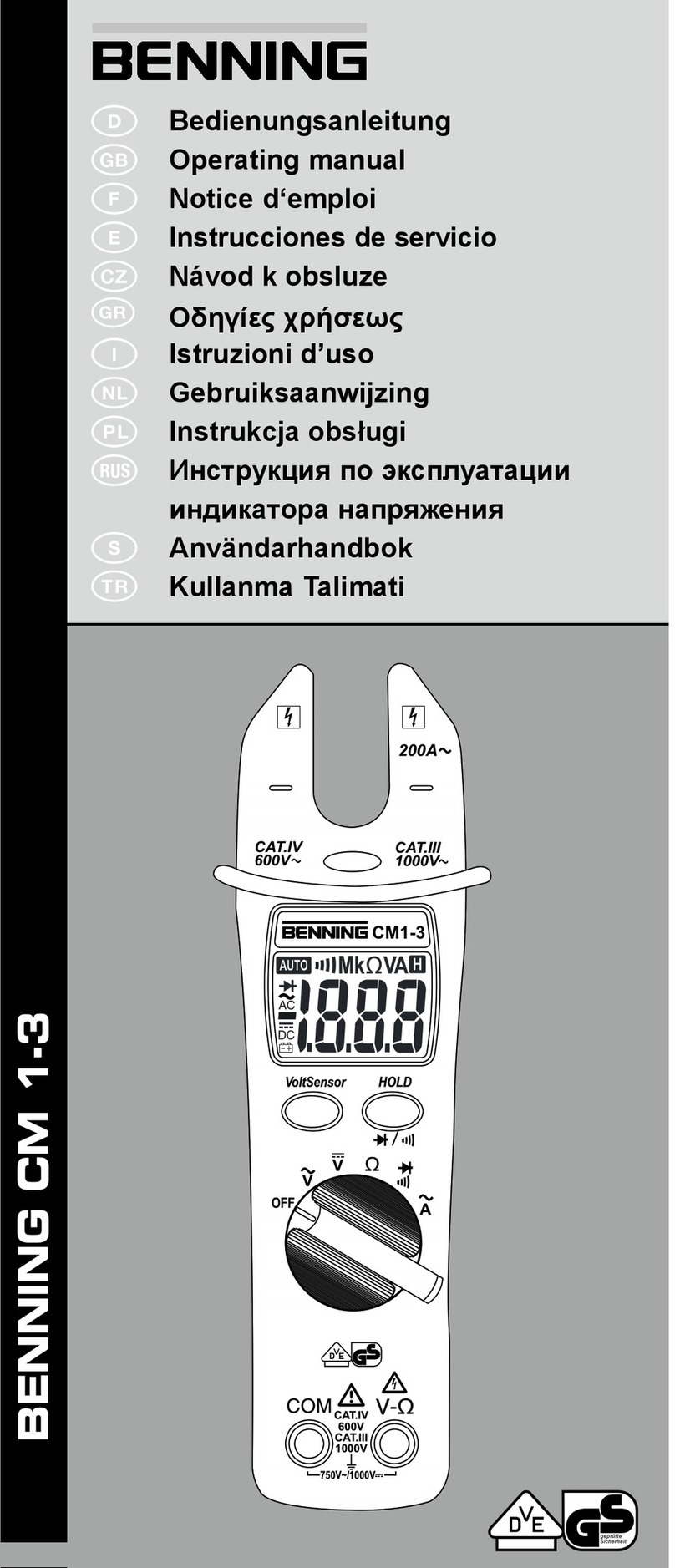
Benning
Benning CM 1.3 User manual
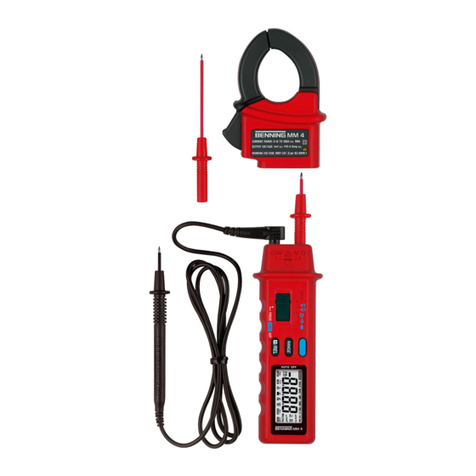
Benning
Benning BEMM4 User manual
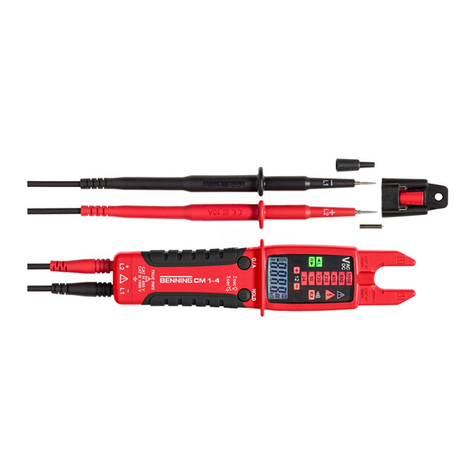
Benning
Benning CM 1-4 User manual
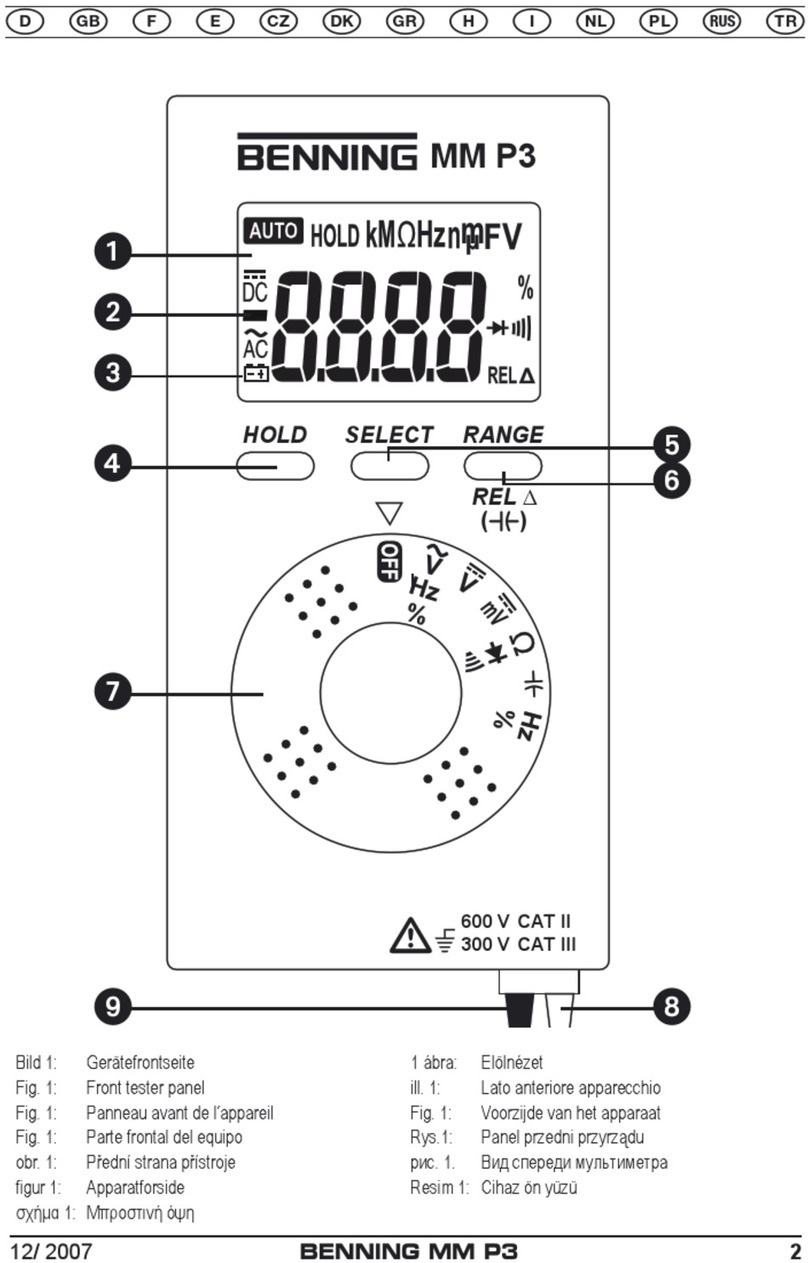
Benning
Benning MM P3 User manual
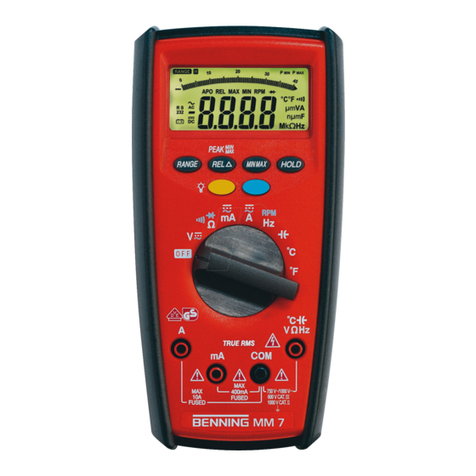
Benning
Benning MM 7 User manual

Benning
Benning MM 1 User manual
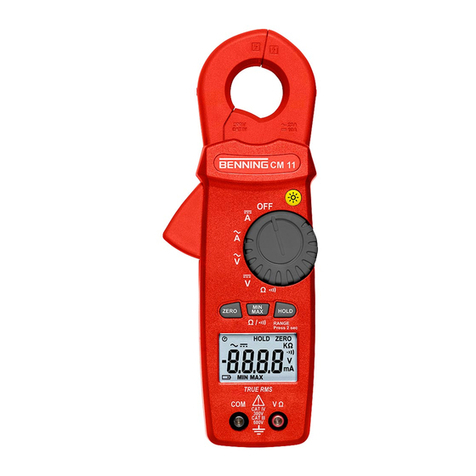
Benning
Benning CM11 User manual
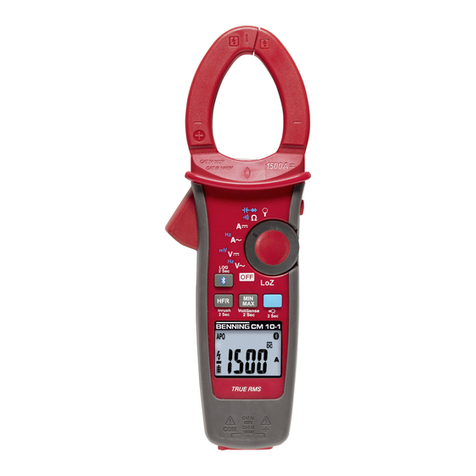
Benning
Benning CM 10-PV User manual
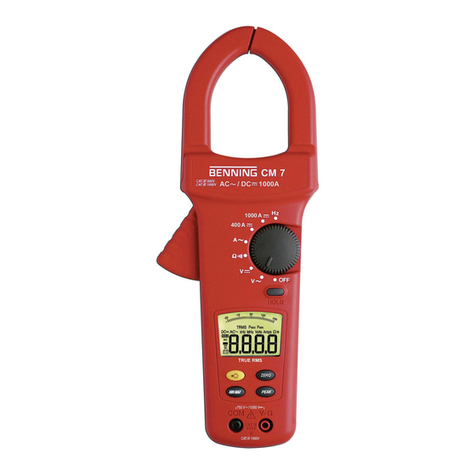
Benning
Benning CM 7 User manual
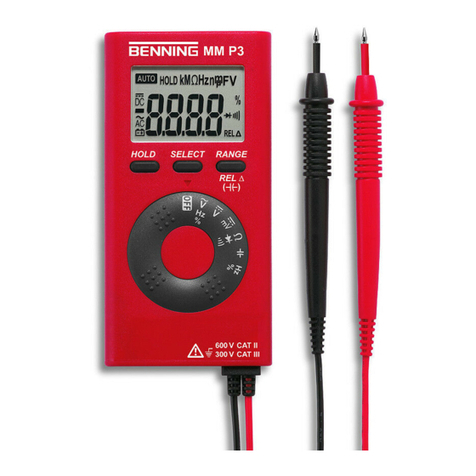
Benning
Benning MM P3 User manual
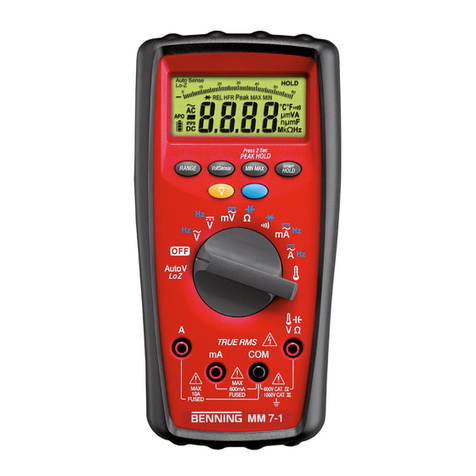
Benning
Benning MM 7-1 User manual

Benning
Benning CM 9 User manual
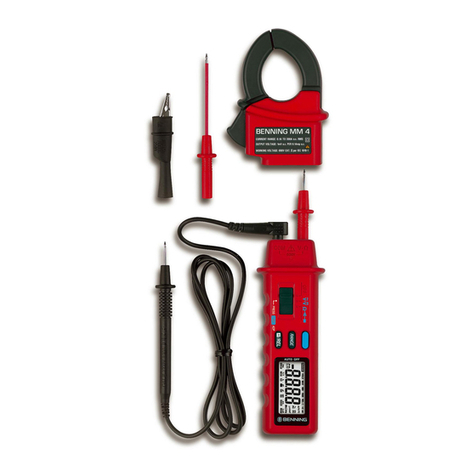
Benning
Benning MM4 User manual
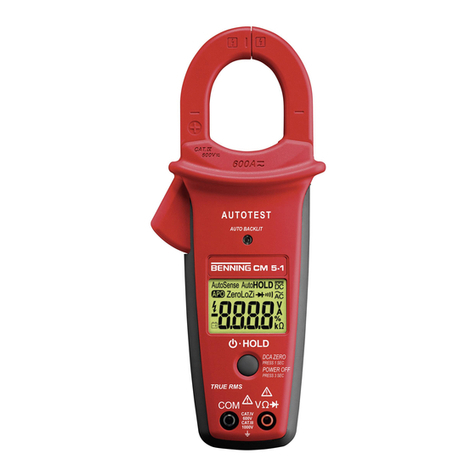
Benning
Benning CM 5-1 User manual
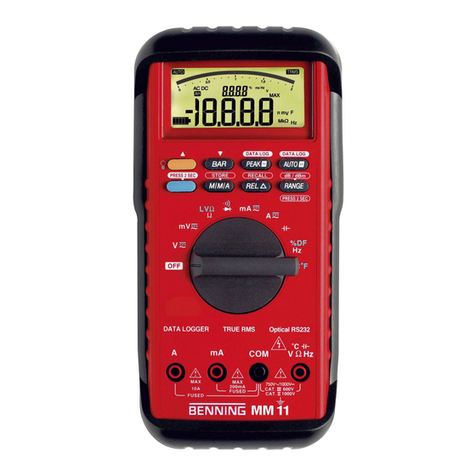
Benning
Benning MM 1-1 User manual
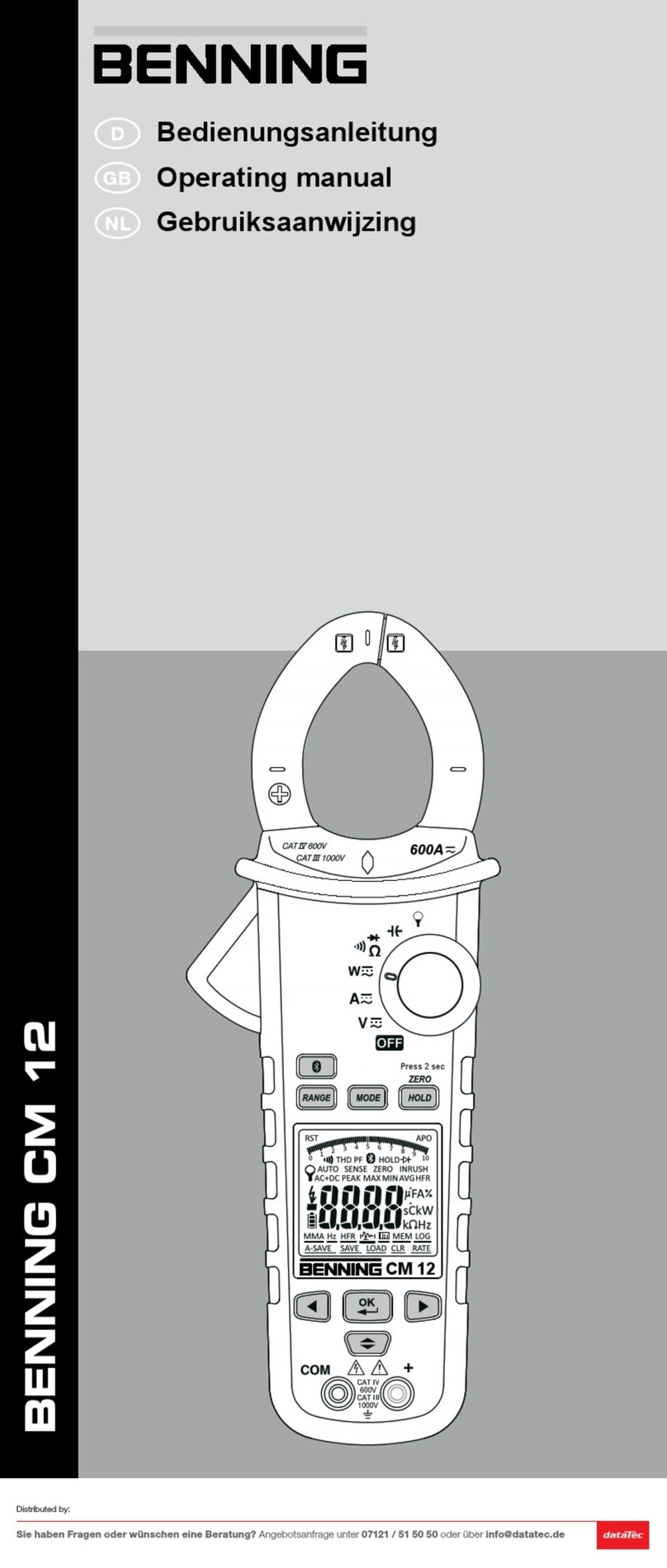
Benning
Benning 044680 User manual
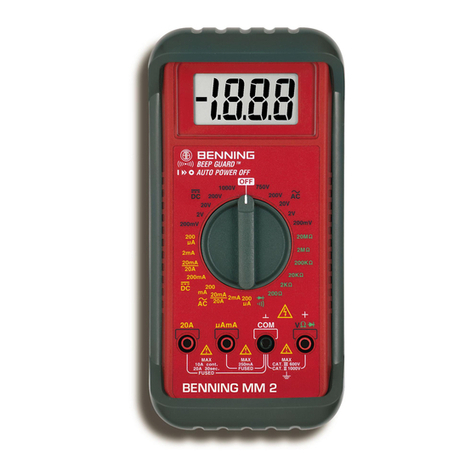
Benning
Benning MM 2 User manual
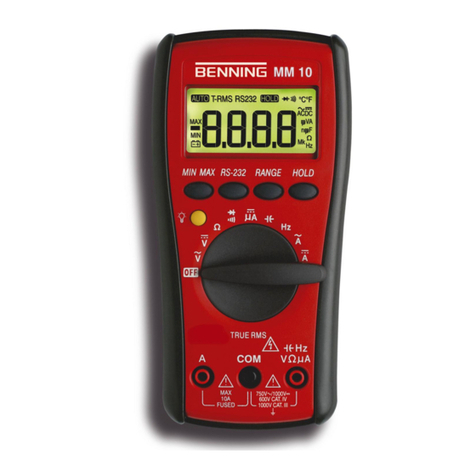
Benning
Benning MM 8 User manual

Benning
Benning MM 1-2 User manual
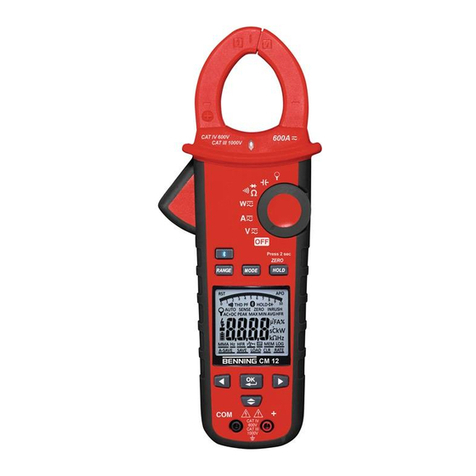
Benning
Benning CM 12 User manual
